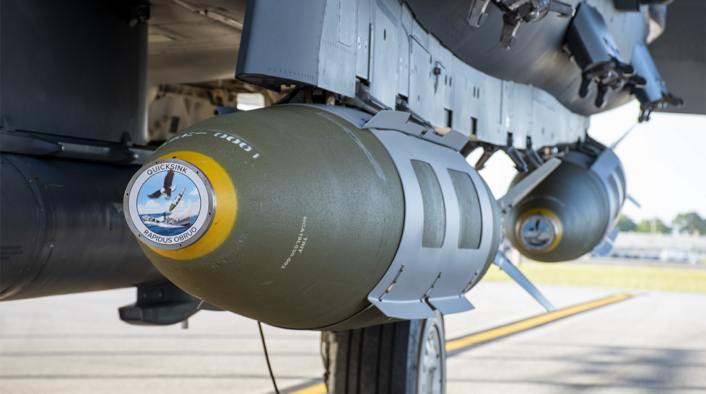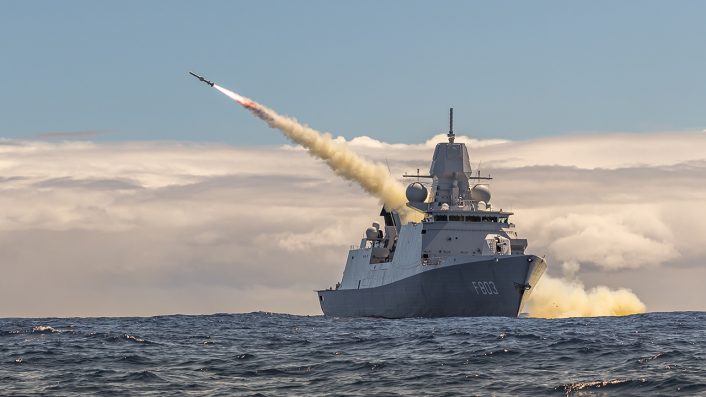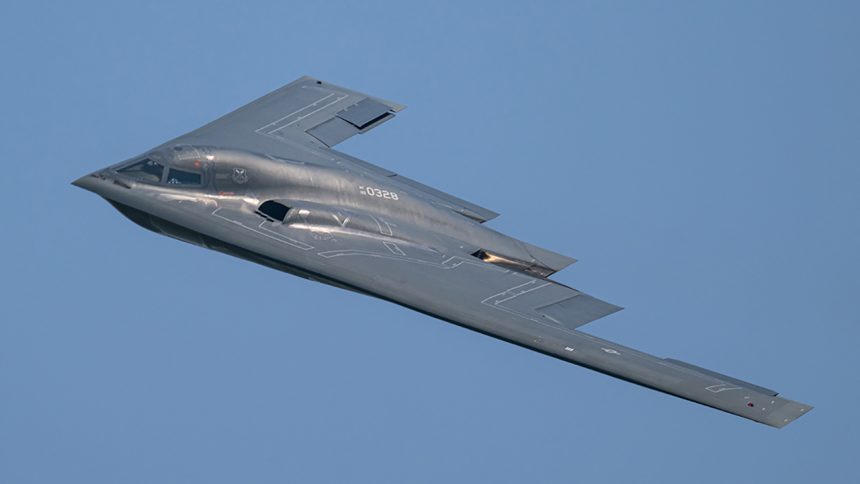The U.S. Air Force B-2 Spirit carried out a QUICKSINK demonstration during the second SINKEX (Sinking Exercise) of RIMPAC 2024. This marks the very first time a B-2 Spirit has been publicly reported to test this anti-ship capability.
RIMPAC 2024, the 29th in the series since 1971, sees the involvement of 29 nations, 40 surface ships, three submarines, 14 national land forces, over 150 aircraft, and 25,000 personnel. During the drills, two long-planned live-fire sinking exercises (SINKEXs) led to the sinking of two decommissioned ships: USS Dubuque (LPD 8), sunk on July 11, 2024; and the USS Tarawa (LHA 1), sunk on July 19. Both were sunk in waters 15,000 feet deep, located over 50 nautical miles off the northern coast of Kauai, Hawaii.
SINKEXs are training exercises in which decommissioned naval vessels are used as targets. These exercises allow participating forces to practice and demonstrate their capabilities in live-fire scenarios providing a unique and realistic training environment that cannot be replicated through simulations or other training methods.
RIMPAC 2024’s SINKEXs allowed units from Australia, Malaysia, the Netherlands, South Korea, and various U.S. military branches, including the Air Force, Army, and Navy, to enhance their skills and tactics as well as validate targeting, and live firing capabilities against surface ships at sea. They also helped improve the ability of partner nations to plan, communicate, and execute complex maritime operations, including precision and long-range strikes.
LRASM
During the sinking of the ex-Tarawa, a U.S. Navy F/A-18F Super Hornet deployed a Long-Range Anti-Ship Missile (LRASM). This advanced, stealthy cruise missile offers multi-service, multi-platform, and multi-mission capabilities for offensive anti-surface warfare and is currently deployed from U.S. Navy F/A-18 and U.S. Air Force B-1B aircraft.
A US Navy Super Hornet carrying an AMRAAM, LRASM, and Sidewinder being refueled by a USAF KC-135 Stratotanker.
📸: Staff Sgt. Tiffany Emery pic.twitter.com/wkPwHKKRpq
— Doha (@Doha104p3) July 20, 2024
The AGM-158C LRASM, based on the AGM-158B Joint Air-to-Surface Standoff Missile – Extended Range (JASSM-ER), is the new low-observable anti-ship cruise missile developed by DARPA (Defense Advanced Research Projects Agency) for the U.S. Air Force and U.S. Navy. NAVAIR describes the weapon as a defined near-term solution for the Offensive Anti-Surface Warfare (OASuW) air-launch capability gap that will provide flexible, long-range, advanced, anti-surface capability against high-threat maritime targets.
QUICKSINK
Remarkably, in a collaborative effort with the U.S. Navy, a U.S. Air Force B-2 Spirit stealth bomber also took part in the second SINKEX, demonstrating a low-cost, air-delivered method for neutralizing surface vessels using the QUICKSINK. Funded by the Office of the Under Secretary of Defense for Research and Engineering, the QUICKSINK experiment aims to provide cost-effective solutions to quickly neutralize maritime threats over vast ocean areas, showcasing the flexibility of the joint force.
The Quicksink initiative, in collaboration with the U.S. Navy, is designed to offer innovative solutions for swiftly neutralizing stationary or moving maritime targets at a low cost, showcasing the adaptability of joint military operations for future combat scenarios. “Quicksink is distinctive as it brings new capabilities to both current and future Department of Defense weapon systems, offering combatant commanders and national leaders fresh methods to counter maritime threats,” explained Kirk Herzog, the program manager at the Air Force Research Laboratory (AFRL).
Traditionally, enemy ships are targeted using submarine-launched heavyweight torpedoes, which, while effective, come with high costs and limited deployment capabilities among naval assets. “Heavyweight torpedoes are efficient at sinking large ships but are expensive and deployed by a limited number of naval platforms,” stated Maj. Andrew Swanson, division chief of Advanced Programs at the 85th Test and Evaluation Squadron. “Quicksink provides a cost-effective and agile alternative that could be used by a majority of Air Force combat aircraft, thereby expanding the options available to combatant commanders and warfighters.”
Regarding weapon guidance, the QUICKSINK kit combines a GBU-31/B Joint Direct Attack Munition’s existing GPS-assisted inertial navigation system (INS) guidance in the tail with a new radar seeker installed on the nose combined with an IIR (Imaging Infra-Red) camera mounted in a fairing on the side. When released, the bomb uses the standard JDAM kit to glide to the target area and the seeker/camera to lock on the ship. Once lock on is achieved, the guidance system directs the bomb to detonate near the hull below the waterline.
Previous QUICKSINK demonstrations in 2021 and 2022 featured F-15E Strike Eagles deploying modified 2,000-pound GBU-31 JDAMs. This marks the very first time a B-2 Spirit has been publicly reported to test this anti-ship capability. Considering a B-2 can carry up to 16 GBU-31 JDAMs, this highlights the significant anti-surface firepower a single stealth bomber can bring to a maritime conflict scenario.

SINKEXs
“Sinking exercises allow us to hone our skills, learn from one another, and gain real-world experience,” stated U.S. Navy Vice Adm. John Wade, the RIMPAC 2024 Combined Task Force Commander in a public statement. “These drills demonstrate our commitment to maintaining a safe and open Indo-Pacific region.”
Ships used in SINKEXs, known as hulks, are prepared in strict compliance with Environmental Protection Agency (EPA) regulations under a general permit the Navy holds pursuant to the Marine Protection, Research, and Sanctuaries Act. Each SINKEX requires the hulk to sink in water at least 6,000 feet deep and more than 50 nautical miles from land.
In line with EPA guidelines, before a SINKEX, the Navy thoroughly cleans the hulk, removing all materials that could harm the marine environment, including polychlorinated biphenyls (PCBs), petroleum, trash, and other hazardous materials. The cleaning process is documented and reported to the EPA before and after the SINKEX.

SINKEXs are conducted only after the area is surveyed to ensure no people, marine vessels, aircraft, or marine species are present. These exercises comply with the National Environmental Policy Act and are executed following permits and authorizations under the Marine Mammal Protection Act, Endangered Species Act, and Marine Protection, Research, and Sanctuaries Act.
The ex-Dubuque, an Austin-class amphibious transport dock, was commissioned on September 1, 1967, and served in Vietnam, Operation Desert Shield, and other missions before being decommissioned in June 2011. The ex-Tarawa, the lead amphibious assault ship of its class, was commissioned on May 29, 1976, participated in numerous operations including Desert Shield and Iraqi Freedom, and was decommissioned in March 2009.
This year marks the second time a Tarawa-class ship has been used for a SINKEX, following the sinking of the ex-USS Belleau Wood (LHA 3) during RIMPAC 2006.
H/T Ryan Chan for the heads up!









